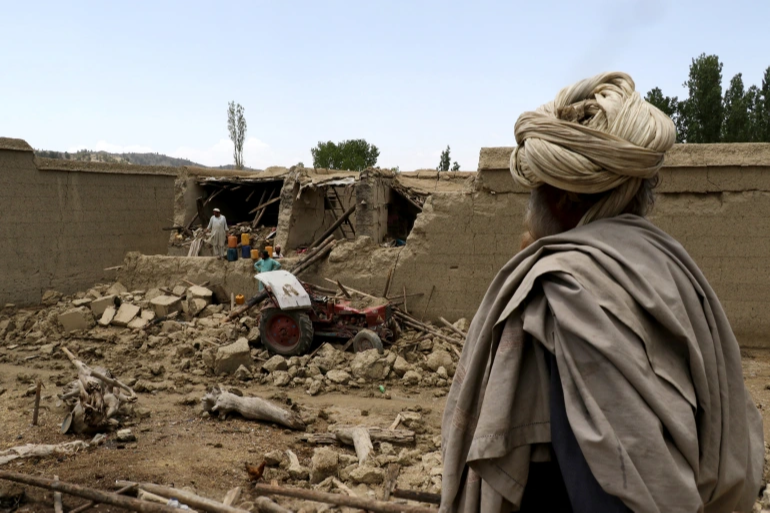
Afghan men examine the damage to their houses on June 23, 2022 after the earthquake in Gayan, Afghanistan [Photo: Reuters]
Kabul, June 25 (RHC)-- In the early morning hours of Wednesday June 22nd, the mud homes in this remote part of southeastern Afghanistan began to tremble and collapse under the force of a 5.9-magnitude earthquake.
Panicked residents tried to wake their sleeping relatives. But for hundreds of families, there was no time. Within minutes the mud roofs on the homes in Gayan district, where poor families of up to 15 people lived together, came crashing down on those still inside.
In the hours that passed after those first terrifying tremors, the death toll climbed. By the time residents in the Afghan capital Kabul awoke to the news of the earthquake in the remote eastern regions of the country, the number of dead had already reached 90. It would exceed 1,000 dead, including at least 121 children, by evening time.
Now, three days later, the death toll has exceeded 1,100, and hundreds are injured. “Every house here has lost multiple people; everyone’s houses are destroyed. Whatever we had is now gone,” said Ali Khan, recounting how 10 family members were killed in the earthquake, including children.
Having grown up in Gayan, the 35-year-old said the economic conditions of local villagers was a factor in the scale of the destruction and the death toll.
Nestled in rocky, unpaved mountains and hillsides, the remoteness of these poor villages and their rudimentary homes of mud and wood was cited as a major cause of the fatalities among residents in Khost and Paktika – the two provinces that were most affected by the earthquake.
“Everyone is poor here, they build simple houses with what they have,” said Khan as he surveyed the cracked walls of his family’s mud home atop a dry, dusty hill in this remote region of the country.
The Afghan Ministry of Defence began deploying helicopters to the affected districts on Wednesday morning, but by mid-afternoon those flights had to be halted due to torrential rain, hail, and heavily clouded conditions over Kabul and neighbouring provinces.
Health workers in Paktia province, home to the regional hospital for Afghanistan’s southeastern zone, told Al Jazeera that the delayed helicopter flights greatly affected the ability of aid workers and medical professionals to assist those most in need.
When the helicopter flights did resume, the demand was overwhelming. One pilot conducting flights between Paktika and neighbouring Paktia province, said he could not believe what he saw each time his helicopter landed in one of the affected areas.
“You don’t know who to help first. It’s just a rush of people trying desperately to get on board,” he said, re-starting the engine of his helicopter for yet another flight.
Samira Sayed Rahman, communication and advocacy coordinator at the International Rescue Committee (IRC), said her organization had deployed mobile medical units to Khost and Paktika, but that the need remained great.
IRC was fortunate that they had teams in the two provinces and in Kabul who were familiar with the communities and the geographies of the affected areas, Sayed Rahman said. “Our mobile health team in Spera (district) reported that most of the deaths, and the victims they are treating in the district, are of women.”

